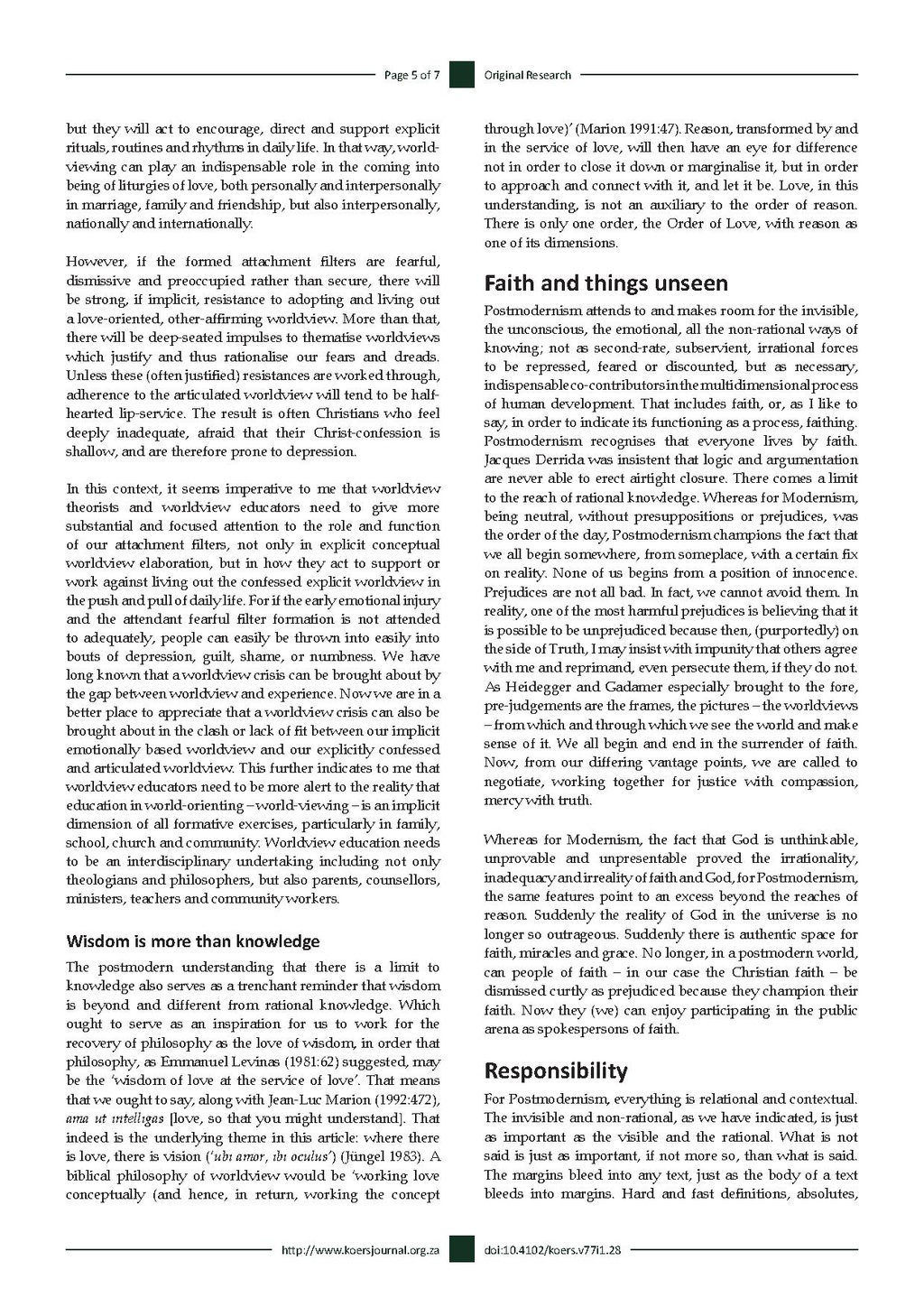Page 5 of 7 | Original Research
but they will act to encourage, direct and support explicit rituals, routines and rhythms in daily life. In that way, worldviewing can play an indispensable role in the coming into being of liturgies of love, both personally and interpersonally in marriage, family and friendship, but also interpersonally, nationally and internationally.
However, if the formed attachment filters are fearful,
dismissive and preoccupied rather than secure, there will be strong, if implicit, resistance to adopting and living out a love-oriented, other-affirming worldview. More than that,
there will be deep-seated impulses to thematise worldviews
which justify and thus rationalise our fears and dreads.
Unless these (often justified) resistances are worked through,
adherence to the articulated worldview will tend to be halfhearted lip-service. The result is often Christians who feel deeply inadequate, afraid that their Christ-confession is
shallow, and are therefore prone to depression.
In this context, it seems imperative to me that worldview
theorists and worldview educators need to give more
substantial and focused attention to the role and function of our attachment filters, not only in explicit conceptual
worldview elaboration, but in how they act to support or work against living out the confessed explicit worldview in the push and pull of daily life. For if the early emotional injury
and the attendant fearful filter formation is not attended to adequately, people can easily be thrown into easily into bouts of depression, guilt, shame, or numbness. We have long known that a worldview crisis can be brought about by the gap between worldview and experience. Now we are in a better place to appreciate that a worldview crisis can also be
brought about in the clash or lack of fit between our implicit
emotionally based worldview and our explicitly confessed and articulated worldview. This further indicates to me that
worldview educators need to be more alert to the reality that
education in world-orienting – world-viewing – is an implicit
dimension of all formative exercises, particularly in family,
school, church and community. Worldview education needs to be an interdisciplinary undertaking including not only
theologians and philosophers, but also parents, counsellors,
ministers, teachers and community workers.
Wisdom is more than knowledge
The postmodern understanding that there is a limit to knowledge also serves as a trenchant reminder that wisdom is beyond and different from rational knowledge. Which ought to serve as an inspiration for us to work for the recovery of philosophy as the love of wisdom, in order that philosophy, as Emmanuel Levinas (1981:62) suggested, may be the ‘wisdom of love at the service of love’. That means that we ought to say, along with Jean-Luc Marion (1992:472), ama ut intelligas [love, so that you might understand]. That indeed is the underlying theme in this article: where there is love, there is vision (‘ubi amor, ibi oculus’) (Jüngel 1983). A biblical philosophy of worldview would be ‘working love conceptually (and hence, in return, working the concept through love)’ (Marion 1991:47). Reason, transformed by and in the service of love, will then have an eye for difference not in order to close it down or marginalise it, but in order to approach and connect with it, and let it be. Love, in this understanding, is not an auxiliary to the order of reason. There is only one order, the Order of Love, with reason as one of its dimensions.
Faith and things unseen
Postmodernism attends to and makes room for the invisible, the unconscious, the emotional, all the non-rational ways of knowing; not as second-rate, subservient, irrational forces to be repressed, feared or discounted, but as necessary, indispensable co-contributors in the multidimensional process of human development. That includes faith, or, as I like to say, in order to indicate its functioning as a process, faithing. Postmodernism recognises that everyone lives by faith. Jacques Derrida was insistent that logic and argumentation are never able to erect airtight closure. There comes a limit to the reach of rational knowledge. Whereas for Modernism, being neutral, without presuppositions or prejudices, was the order of the day, Postmodernism champions the fact that we all begin somewhere, from someplace, with a certain fix on reality. None of us begins from a position of innocence. Prejudices are not all bad. In fact, we cannot avoid them. In reality, one of the most harmful prejudices is believing that it is possible to be unprejudiced because then, (purportedly) on the side of Truth, I may insist with impunity that others agree with me and reprimand, even persecute them, if they do not. As Heidegger and Gadamer especially brought to the fore, pre-judgements are the frames, the pictures – the worldviews – from which and through which we see the world and make sense of it. We all begin and end in the surrender of faith. Now, from our differing vantage points, we are called to negotiate, working together for justice with compassion, mercy with truth.
Whereas for Modernism, the fact that God is unthinkable,
unprovable and unpresentable proved the irrationality,
inadequacy and irreality of faith and God, for Postmodernism,
the same features point to an excess beyond the reaches of
reason. Suddenly the reality of God in the universe is no
longer so outrageous. Suddenly there is authentic space for
faith, miracles and grace. No longer, in a postmodern world,
can people of faith – in our case the Christian faith – be
dismissed curtly as prejudiced because they champion their
faith. Now they (we) can enjoy participating in the public
arena as spokespersons of faith.
Responsibility
For Postmodernism, everything is relational and contextual. The invisible and non-rational, as we have indicated, is just as important as the visible and the rational. What is not said is just as important, if not more so, than what is said. The margins bleed into any text, just as the body of a text bleeds into margins. Hard and fast definitions, absolutes,
http://www.koersjournal.org.za | doi:10.4102/koers.v77i1.28
